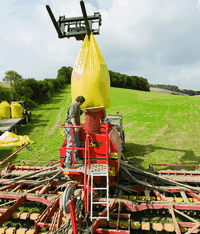Zone seeding may bring better establishment

The potential benefits of adjusting seed rates to soil zones have persuaded a Wiltshire farm manager to apply the technique over his whole acreage this season.
Duncan Lee’s move at Ramsbury Estate near Marlborough follows his adoption of a system of varying phosphate, potash and magnesium fertiliser, and more recently nitrogen applications to winter wheat and oilseed rape, according to in-field zones. These have been identified with the help of The Courtyard Partnership in Swindonusing its Intelligent Precision Farming service (Arable, 23 March).
The use for nitrogen was trialled on blocks of rape and wheat last season with interesting results, says Mr Lee.“In the past we averaged about 220kg/ha of N in total on our winter wheat and 200kg/ha on our oilseed rape.”
Last season, using zone guidance, the figure was only 165kg/ha on wheat and 130kg/ha on rape.
“We saw no loss of yield compared with our five-year average.
“The aim of extending the idea to drilling is to make sure we get tillers numbers right,” he says.
A small variable seeding trial last season on oilseed rape encouraged him to try the approach using the farm’s new Vaderstad Rapid 8m drill across the whole 2025ha (5000 acres) this autumn.Varying sowing rates on the estate’s hilly land with its wide range of soil types and fertility makes a lot of sense, he believes.
Although rates on modern drills can easily be modified to take account of obvious field variations, the IPF system offers much more precision and flexibility, says the company’s Vince Gillingham.
Software from Farm Works and Farmade allows the firm to offer a GPS-linked Personal Data Assistant, which in effect drives the drill adjustments according to field zones already mapped.A small in-cab screen on the PDA displays the zones and the area sown.
“We don’t make the decisions on what rates to use,” stresses Mr Gillingham. “We simply offer the equipment and our precision farming experience as a tool for farmers and their agronomists to use.”
Initial basic rates are determined by Mr Lee and Masstock’s Jim Hynes.“It’s a bit of a grey area,” admits Mr Lee. “We have huge variations to deal with. Some of our fields have six different zones and soils ranging from thin chalks on top of the downs where we need to bump up rates, to valley bottoms where we need to cutthem.”
The farm’s policy, to sow early at low rates, is an added complication if drilling is delayed and seed orders have to be topped up.
 Ramsbury Estate staff believe zone-guided drilling should improve establishment on their diverse and hilly downland. |
In the field, assistant manager Martyn Hall modifies the PDA’s settings to take account of day-to-day conditions. For now that requires stylus strokes on the touch-screen and closing and reopening a file. But soon on-the-move adjustment will be built into the software, says Mr Gillingham.Should the GPS signal be lost, the drill setting reverts to a default to avoid unsown areas, he notes.
“It does what it says on the box,” says Mr Hall. “The only thing I’d like to see is a bigger screen.”
Apart from the £1500 cost of the Farm Works PDA and the £25 cable to connect it to the drill’s metering monitor, the only outlay is the annual £1.50/ha IPF variable application programming and support charge.
Now all that remains to be seen is how effective the latest fine-tuning approach has been, says Mr Lee.“I’m looking forward to next February to see what plant counts we’ve achieved.”
| Zone Seeding |
|---|
|

